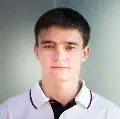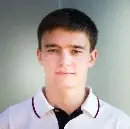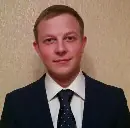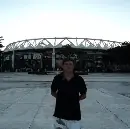How Benetton Launched an Omnichannel Loyalty Program with Product Recommendations Based on ML-driven Cross-channel Campaigns
How Benetton Launched an Omnichannel Loyalty Program with Product Recommendations Based on ML-driven Cross-channel Campaigns
Challenges
Increase revenue
Solutions
Launch an omnichannel loyalty program to increase ARPU and order conversions
Results
Several hundred thousand dollars of additional revenue relative to the global control group, with a statistically significant result and a confidence level of 95%
Integrated with:
Online store, back-office software, Diebold Nixdorf POS system
Noteworthy features
Digital iOS and Android wallets
My name is Andrew — I’m a customer success manager at Maestra. In this post I’ll be detailing how the CIS division of United Colors of Benetton launched the omnichannel Color Club loyalty program. Color Club operates online and in 17 offline points and with multi-channel product recommendations based on machine learning, 19 automated email campaigns and SMS channels, as well as virtual wallets for Android and iOS devices. With the help of the Color Club, UCoB earned several hundred thousand dollars of additional revenue over three months relative to the control group. Get ready to dive into a long read! :)
We are proud that the CIS team became the world’s first United Colors of Benetton division to launch an omnichannel loyalty program that works simultaneously online and offline. Read on to see testimonials from United Colors of Benetton’s Ecommerce Director in the CIS, Alex Vologodsky, as well as feedback from his team.
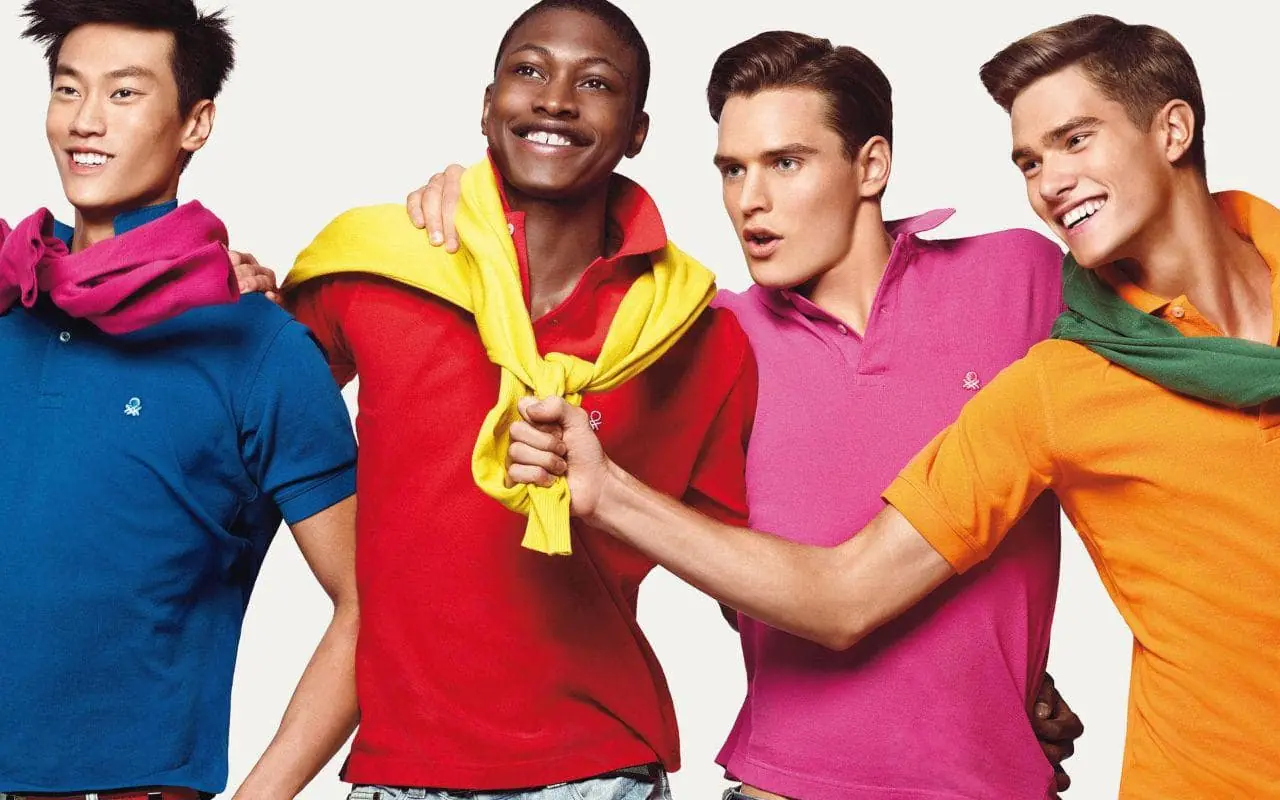
Backstory
A year ago, our colleagues’ marketing at United Colors of Benetton wasn’t doing so great. Purchases in offline stores were anonymous, so marketers didn’t have any information on purchase histories, interests, and preferences of offline customers. The team wanted to analyze offline campaign statistics, but it was unclear how to approach this. In addition, without a loyalty program, it was impossible to calculate a customer’s lifetime value, the number of orders per person, as well as the purchase frequency.
UCoB wanted to reward their loyal customers with gifts and recommend new items that matched their preferences — but without purchase histories, this was impossible. The online store provided some useful information, but this wasn’t enough, as customer behavior offline is different. In addition, not all offline buyers like to shop online.
The brand wanted to find a technological solution that would help centralize customer data, store purchase data, and allow the team to set up personal promotions and automated communications in a single window. Moreover, they wanted to be able to test the reliability of their approach relative to a control group.
In other words, the United Colors of Benetton team were looking for a marketing platform that:
- Could be used as a single hub for customer data, for segmenting an audience based on behavioral data in order to run automated communications and personal offers.
- Can create personalized offers offline and online, based on a customer’s purchase history and preferences.
- Can make personalized recommendations based on online and offline sales data.
- Can be used to set up automated communications through different channels: email, SMS, and virtual wallets.
- Can measure the results of personalized offers relative to a control group.
We chose to go with Maestra’s CDP. Prior to Maestra, United Colors of Benetton did not have a loyalty program or automated communications in place. All messages were sent manually, and it was impossible to segment customers based on offline and online data. Everything was done from scratch.
Results
United Colors of Benetton has several business indicators: share of revenue from direct communications relative to total revenue using the last paid channel method and the added revenue relative to the control group. Let’s go into more detail on what we achieved in these metrics.
Share of revenue from direct communications relative to the total revenue from the last paid channel
One of the most important CDP features for United Colors of Benetton are direct communications via email and SMS. Communication efficiency is measured as a share of the brand’s total revenue. For United Colors of Benetton, direct communications generate 20% of the total offline and online revenue. Data was taken from Maestra’s Communications Dashboard, attribution is for the last paid channel.

Share of revenue generated by newsletters (relative to all the revenue generated during the selected period)
Added revenue relative to the control group
In order to reliably measure the benefits of the loyalty program, United Colors of Benetton uses Maestra’s internal control group report. The report shows the difference in added revenue from direct communications relative to customers who do not receive direct communications. The control group was set up in March with the following conditions:
- The control group contains 10% of United Colors of Benetton’s audience.
- The customer has been in the control group for at least 3 months.
The results regarding the online control group (online store) in the loyalty program members segment demonstrated several hundred thousand dollars of added revenue with a confidence level of 95%. The share of revenue from direct communications is ~ 32% of the total online revenue.
The difference in revenue relative to the control group is provided by a higher average customer revenue (ARPU) and greater conversion per order. What’s important to note here is that even where there is no statistically significant difference, newsletter recipients (the main group) demonstrate better results than those who do not receive newsletters (control group), as shown on the graphs below. As per the client’s request, real figures have not been published.
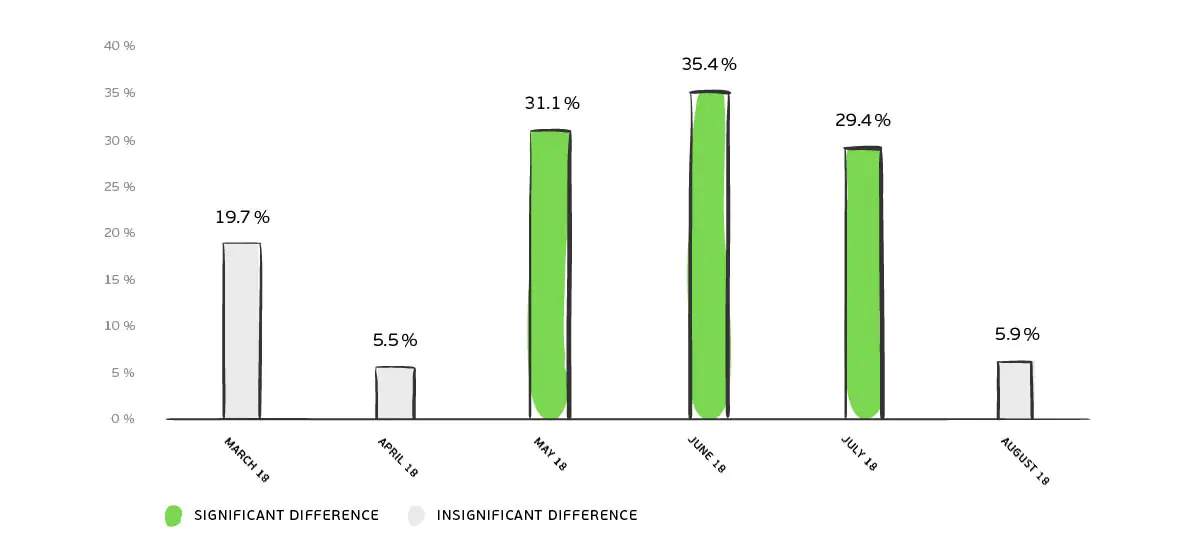
Share of revenue from communications
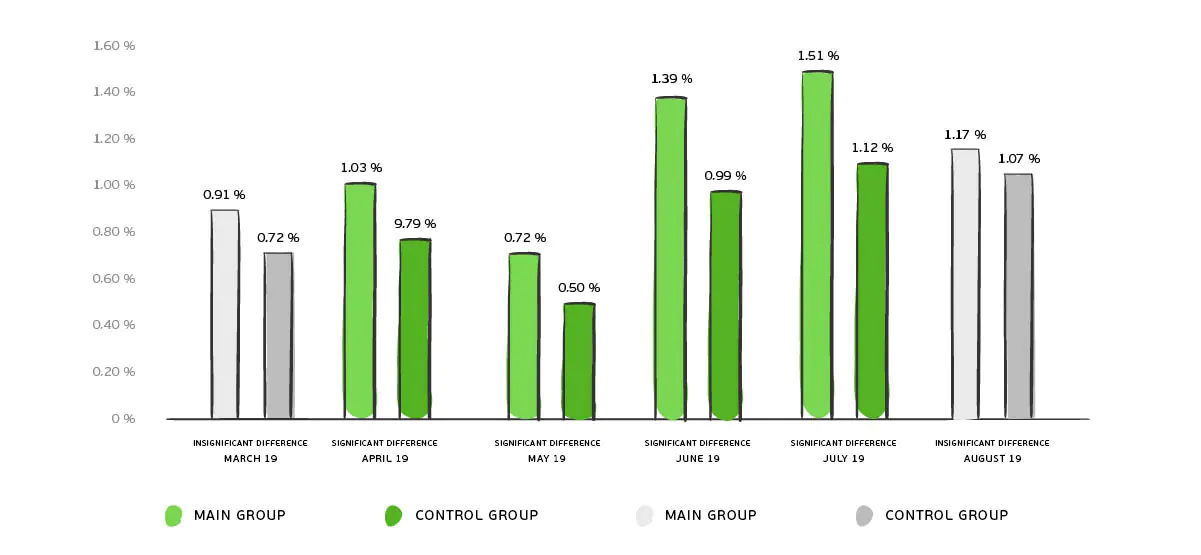
Order conversions
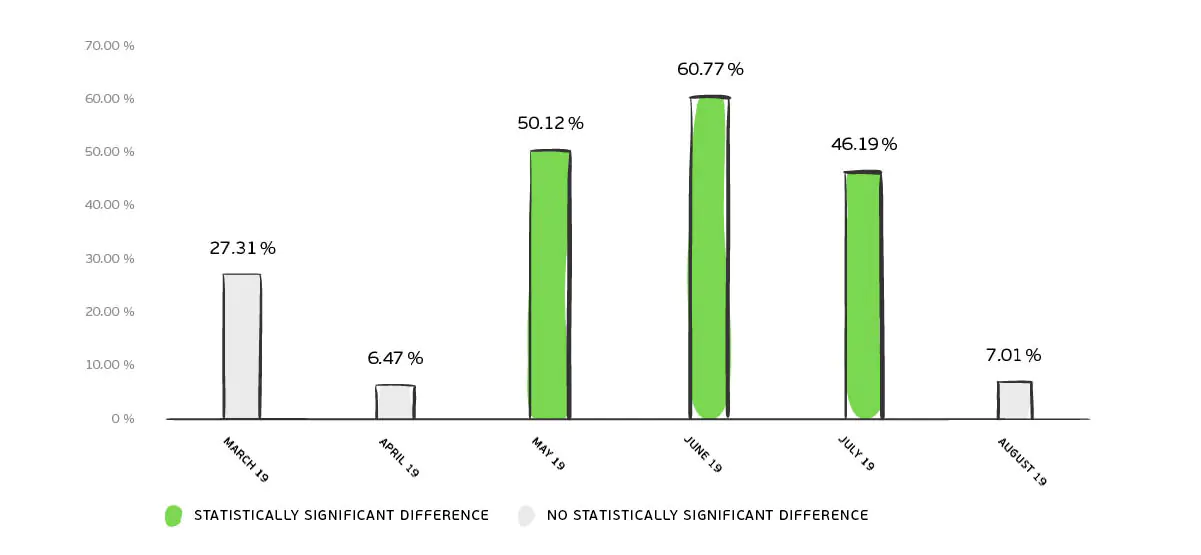
ARPU growth relative to control group
Offline results are similar. A statistically significant difference in revenue relative to the control group was achieved in only one out of the six months. However, in the recipients of the direct communications group, order conversions are significantly higher with a 95% reliability level.

Conversions to orders
How marketing was automated at United Colors of Benetton
Over the past year, we launched dozens of automated campaigns, a loyalty program that works online and offline, connected several communication channels, including email and SMS, set up the Website Personalization module and added personal product recommendations based on machine learning to the website and emails. Product recommendations take into account online and offline customer behavior and create personalized ML-driven collections.
To explore each stage of our work in detail, we would need to write multiple articles :) So in this one, we’ll simply go over the omnichannel loyalty program launch, automated campaigns and multi-channel product recommendations based on machine learning. If you want to learn more, follow the link at the end of this article to read all about how we personalized Benetton’s online store.
It is important for us to understand who our customers are, what motivates them to become our customers, and what may drive them away. This is critical for building a brand. Therefore, our main priority during the last two years has been to digitize interactions between the customer and our brand.
This knowledge will help us refine the selection and procurement processes for clothing collections, more accurately determine our audience and how we position our products, create communications that speak directly to our audience and provide additional services to club members. Thanks to the Maestra team, we as a brand have come closer to our customers.
Launching the Color Club Loyalty Program
Prior to launching the loyalty program, United Colors of Benetton marketers drafted the basic rules for the Color Club loyalty program:
- 60 points = $1.
- 500 points for joining the Color Club.
- Up to 50% of the purchase price can be paid with points.
- 5% of the purchase price is returned in the form of points.
- Personal offers for Color Club members.
- Points can be spent and saved at the same time as part of a single order.
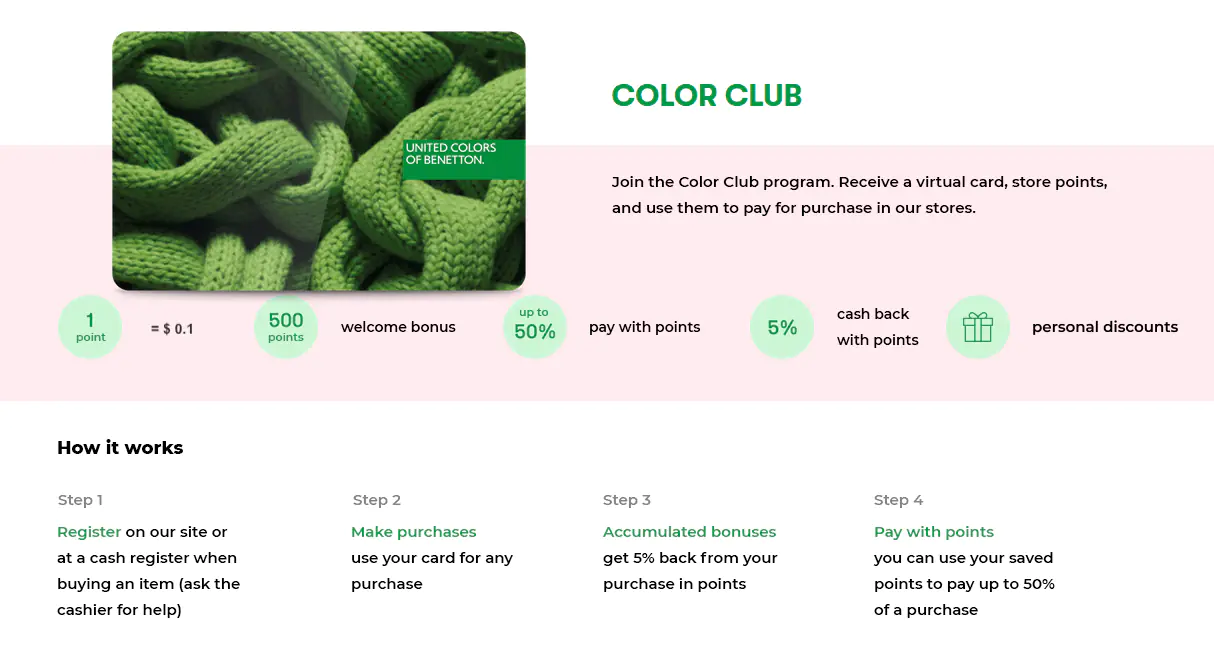
United Colors of Benetton loyalty program rules
After drawing up the rules, the launch of the Color Club program was divided into two stages: offline and offline.
Offline loyalty program launch
To start processing the loyalty program and personal promotions in Maestra, we had to do the following first:
- Integrate Maestra processing into Diebold Nixdorf cash register software.
- Set up promotions for customers in the interface.
Integration of Maestra processing into Diebold Nixdorf Cash Register Software
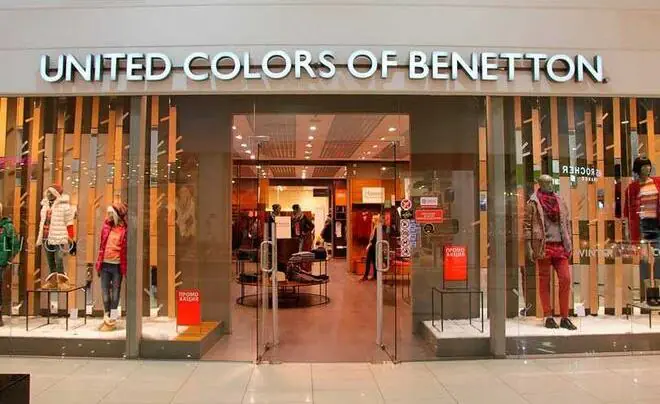
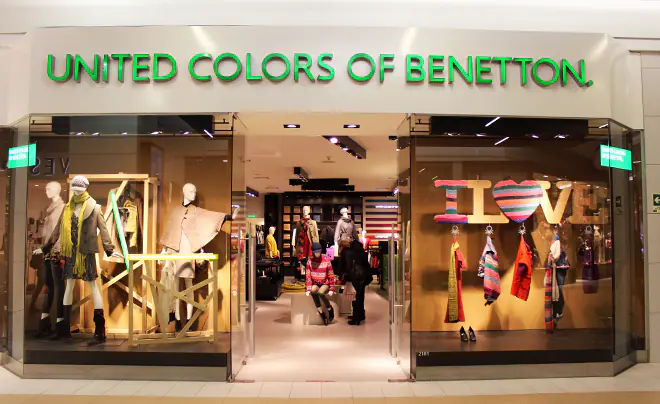
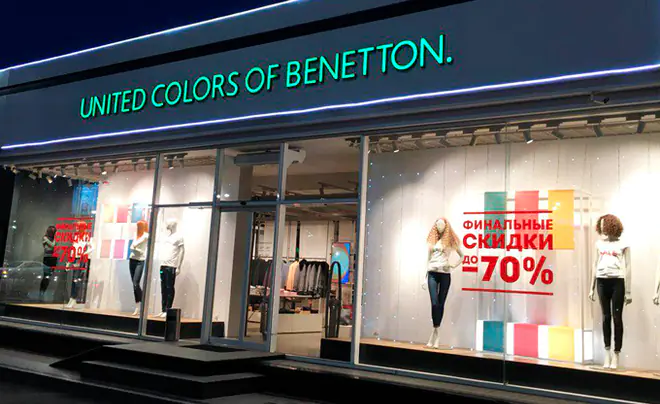
United Colors of Benetton stores
In-store cash registers use Diebold Nixdorf software. The integration was carried out by Diebold itself. The whole process took three months, including a pilot launch and debugging.
After the integration, United Colors of Benetton marketers were able to set up personalized offers for various customer segments through the Maestra interface without involving IT specialists. Personalized offers are made taking into account previous purchases as well as models, styles, colors, and sizes.
Setting up promotions for customers in the interface
Prior to launch, we configured a basic loyalty program. We set up 7 promotions in total at the start: several types of point redemtion mechanisms for different groups of goods and basic point accruals. Everything is configured via the interface, along with direct communications, which I will discuss below. The screenshots below show Color Club settings within the Maestra interface.
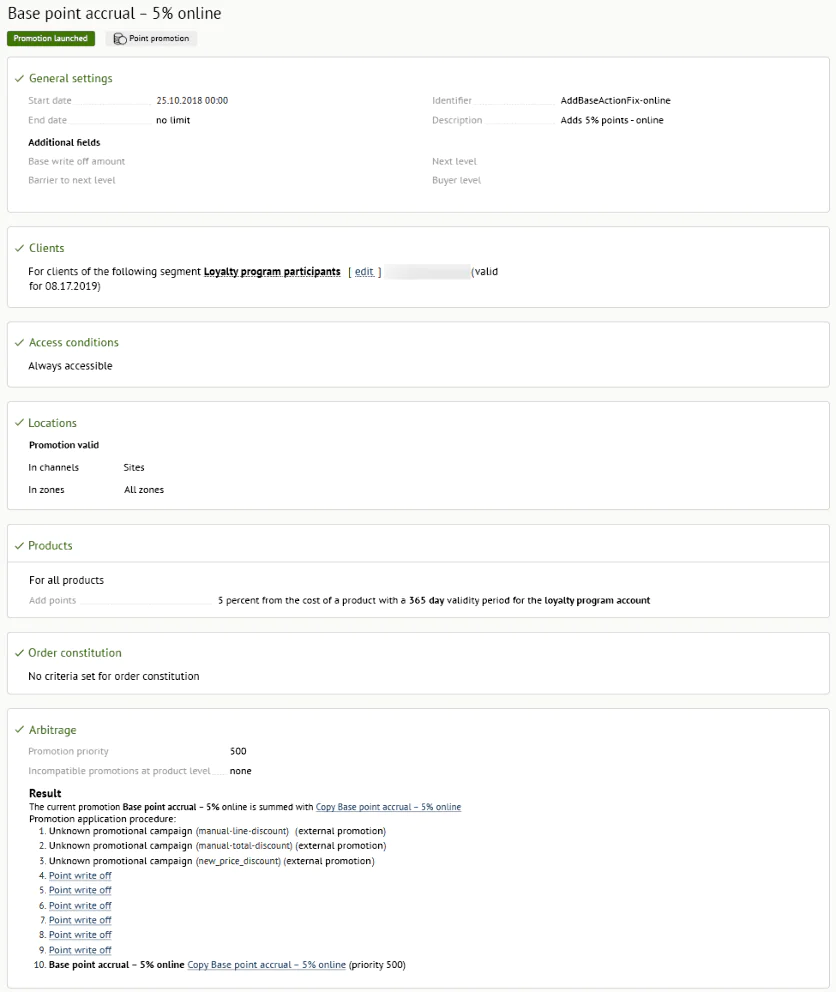
Basic accrual of 5% of the online purchase total
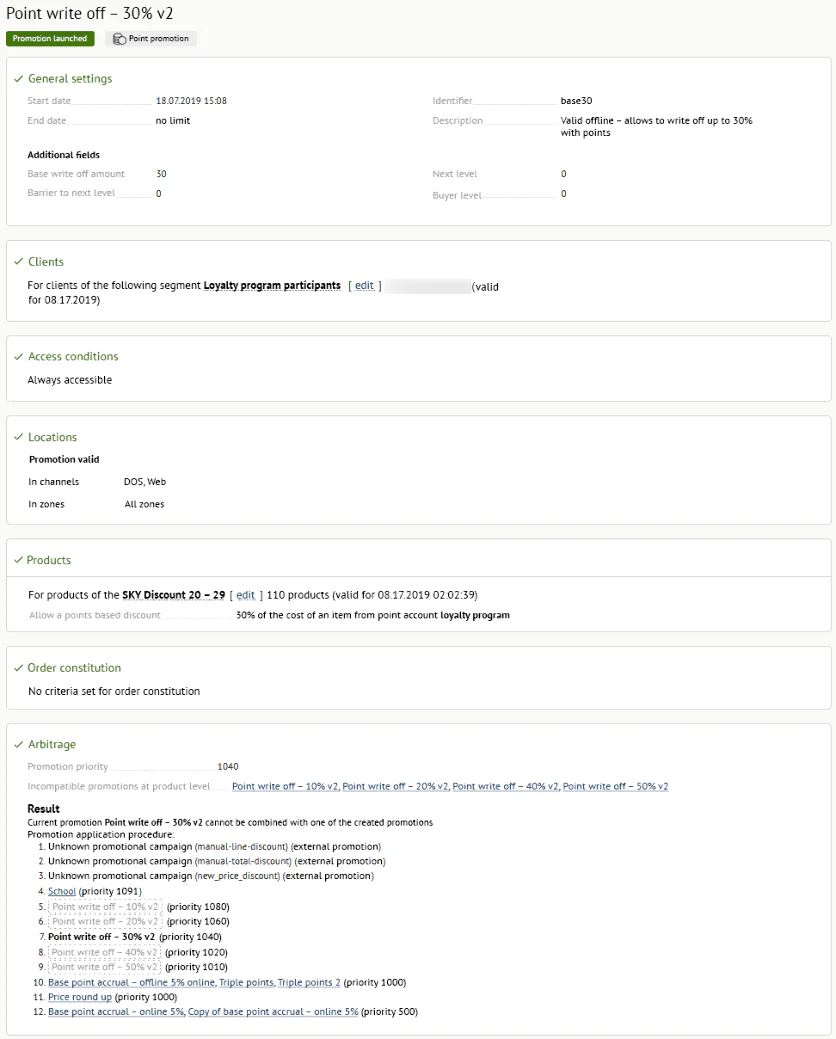
Bonus point redemption of up to 30% for a segment consisting of 110 products
In total, 17 United Colors of Benetton stores participate in the Color Club loyalty program. Customers are authorized at cash registers either using their cell phone number or a virtual Color Club card on iOS and Android wallets.
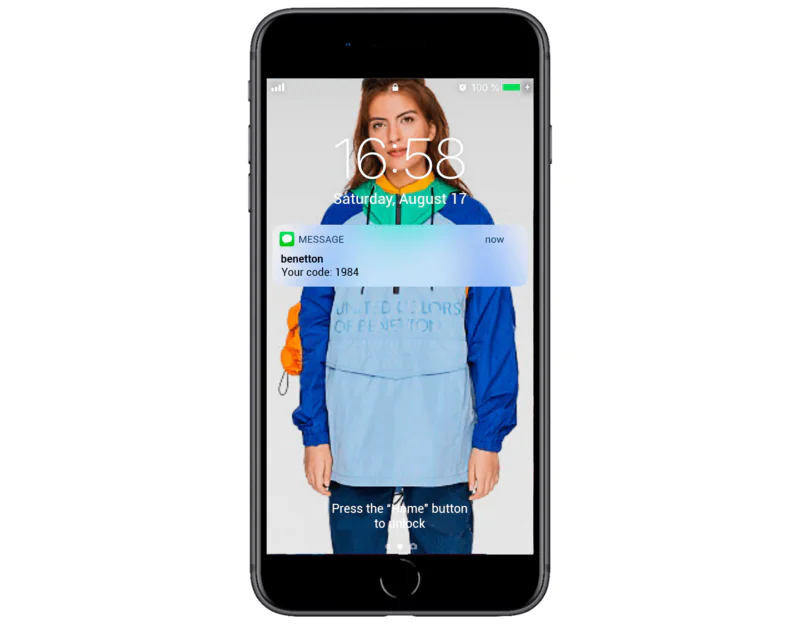
Text message code for authorizations at United Colors of Benetton cash registers
Launching an online loyalty program
The launch of the online Color Club program occurred a few months following the launch of the program offline. Before this, we had to:
- Synchronize and deduplicate offline and online databases.
- Integrate Maestra processing into the back office of the online store.
- Create the Color Club site interface: personal accounts, rules, a menu for confirming contact details, etc.
Sync and deduplicate offline and online databases
Prior to implementing Maestra, United Colors of Benetton stored only online customers’ data. The Maestra CDP has become a united repository of all customer data: purchase history (offline/online), actions pertaining to newsletters, website activity history. The data is used for personalized promotions and communications.
Data deduplication in Maestra occurs automatically. Put simply, deduplication is an automatic data cleaning and merging process. For example, if we find out the date of birth of the customer from an offline source and their email from an online source, then once this data reaches the platform, Maestra will automatically merge the date of birth and email into a single customer profile.

How United Colors of Benetton uses the Maestra platform to personalize customer communications
Integrating Maestra processing into the online store back office
The integration of Maestra processing with the United Colors of Benetton online store was carried out by a third party service. The integration took about two months. After that, Color Club members were able to earn and spend points online or, for example, accumulate points from offline purchases and spend them in the online store.
Processing ensures a data exchange between the online store and Maestra at all order stages, including the shopping cart. For example, in the shopping cart, a customer sees how many points can be spent on the order, and how many can be earned.
Creating the Color Club website interface: customer account page, rules, contact confirmation menu
To make it convenient for customers to take advantage of Color Club features, our expert colleagues designed and set up the website’s interface including pages for phone number authorizations, personal accounts with point balances, information about bonus point accruals and deductions.
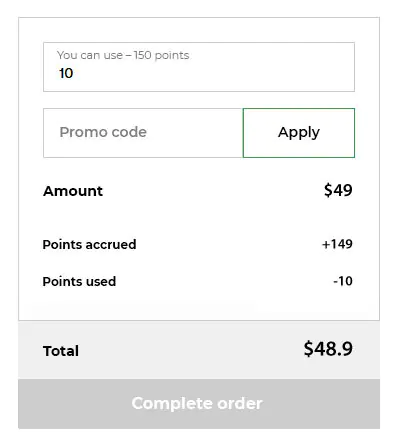
Color Club points information in the shopping cart
In addition to notifications about points in the shopping cart, you can also see additional information such as available points, accruals, and point usage in the profile of a registered Color Club member.
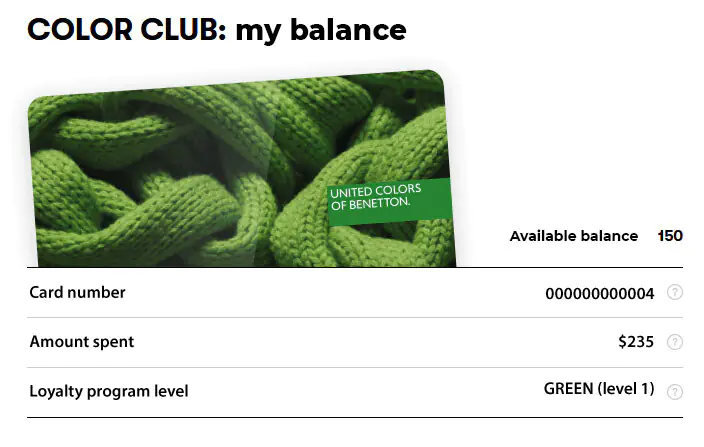
My sample Color Club card within my personal profile in the online store

Sample points history
After launching the Color Club loyalty program offline and online, United Colors of Benetton customers got access to an omnichannel loyalty program with a unified personal account on the wesite, a virtual card, authorizations via SMS and the ability to accumulate and spend points anywhere. The United Colors of Benetton team in the CIS was able to get to know their customers better, started tracking offline repeat purchases, setting up automated campaigns and personal promotions to increase repeat purchases.
To make participation in the Color Club interesting and convenient, launching basic rules simply won’t be enough. To make the loyalty program better, we also wanted to run personal offers and deals for customers via email, SMS, virtual cards, and the website, depending on the preferences of each individual customer. This brings me smoothly over to the next stage — the launch of cross-channel automated communications.
For United Colors of Benetton, the loyalty program was created not only with the goal of granting privileges to club cardholders, but to build mutually beneficial relationships with customers in all channels and touchpoints between them and our brand.
In this regard, it is important for us to get to know our customers as closely as possible in order to develop personalized interactions with them based on purchase histories, interests, communications, and sales channels that are of priority for customers.
We understand that obtaining this knowledge will allow us not only to increase the LTV of our loyal audience, but also offer them the services and privileges that will allow us to create a strong emotional connection between them and our brand. This is exactly what UCoB is striving for in all regions where it is present.
Automated cross-channel communications
During the year in which we worked with United Colors of Benetton, 64 automated campaigns were launched via email, SMS and virtual cards for iOS and Android wallets. It makes no sense to dive into each deployment, so I’ll give you a few examples of the automated campaigns from different channels:
- Email newsletter with bonus points and a QR code for a virtual loyalty card, as well as an intriguing reactivation letter.
- SMS campaign with a reminder about in-store pickup.
- Wallet loyalty card in a digital wallet.
Email newsletter with points and a QR code for a virtual card, and an intriguing reactivation letter
Once a customer registers with Color Club, they get a welcome email with bonus welcome points for their first purchase, as well as a QR code for the quick set up of a virtual card on their smartphone.
If the customer does not spend the 500 welcome points, they’ll get another email asking them to take a survey. The point of the survey is to assess the quality of UCoB service and to figure out why the customer didn’t spend their points.
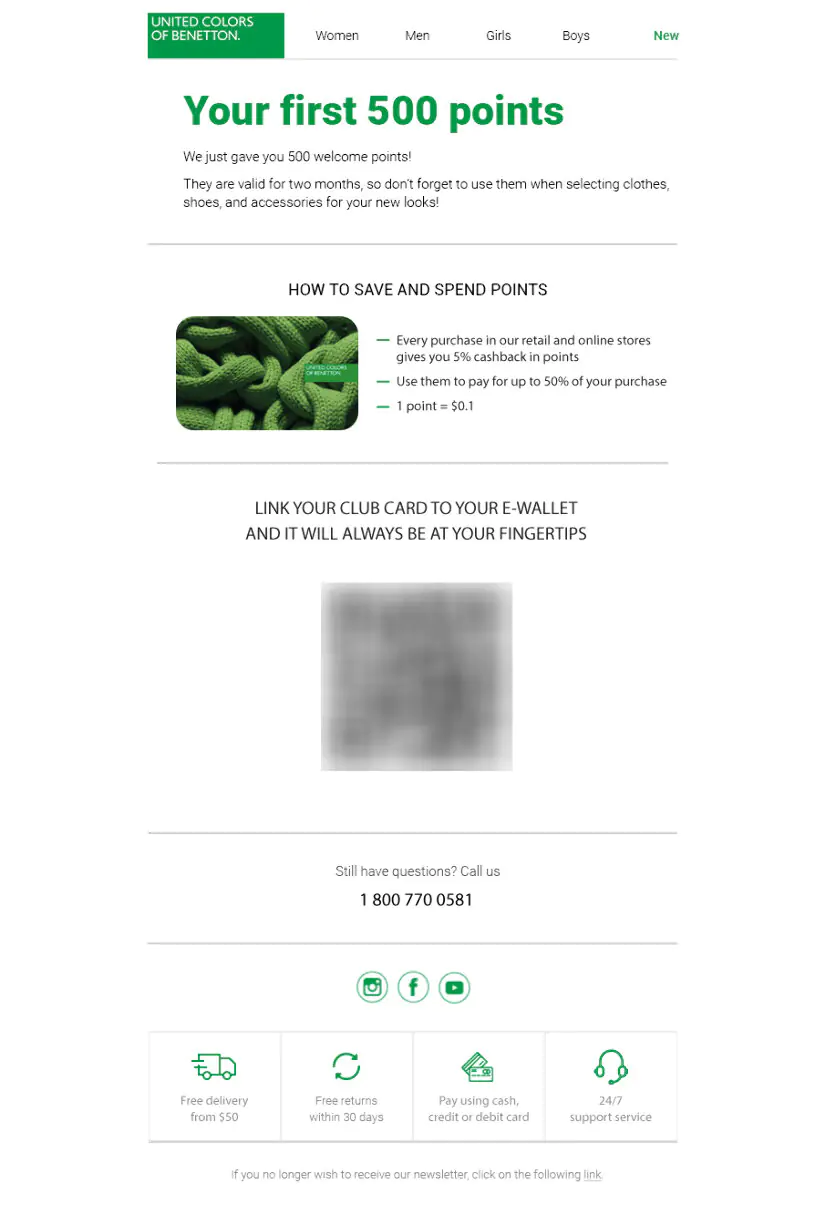
Welcome email with bonus points and a QR code — the latter has been blurred out for security reasons.
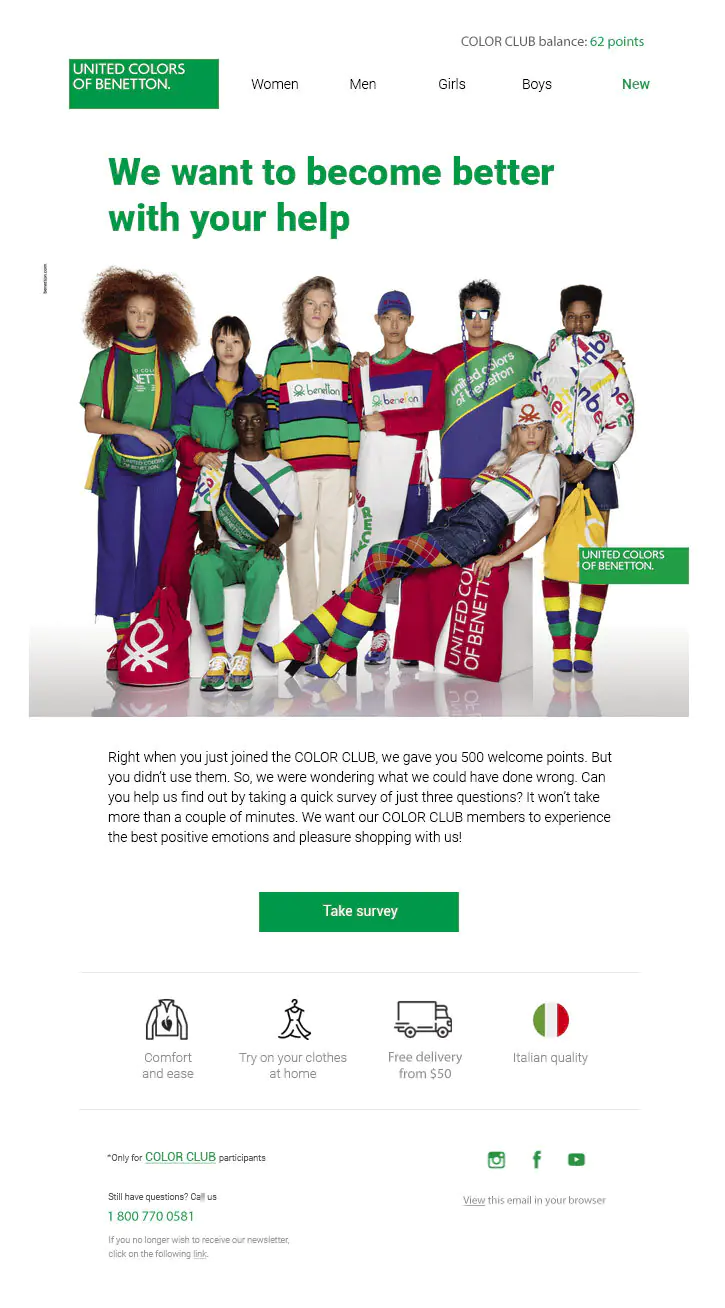
If the customer has not spent their welcome points, they will be sent a survey email
SMS campaign with a reminder about in-store pickup
Since Maestra can monitor order status changes, transactional emails can be configured on the platform. For example, a reminder about an order delivered for in-store pickup that is about to be sent back. If the customer has not collected their order 4 days after the transition of the order to the “Ready for pickup” status, we notify the customer of this via text message.
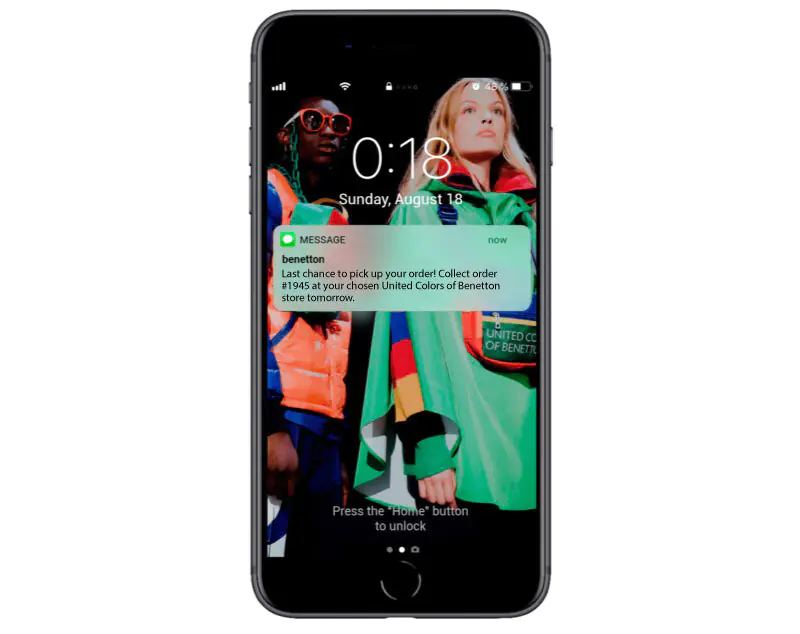
Example of a text message notification for an expiring order
Virtual wallet card
Each member of the Color Club loyalty program receives a link (in an email or text message) for a virtual card that can be installed into an iOS or Android wallet. Using this card, customers can log in at the cash register, receive personalized push notifications, see their number of points and current level in the loyalty program.
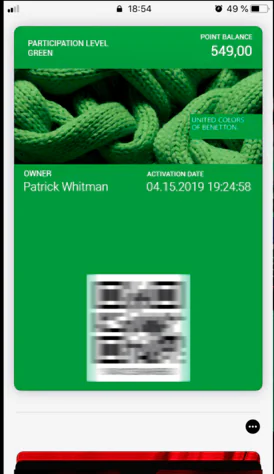
My Color Club loyalty card. The QR code has been blurred
Thus, United Colors of Benetton sets up communications through customer-friendly channels using an interface that removes the need to involve developers.
Multichannel product recommendations based on machine learning
Maestra machine learning product recommendations are an amazing feature and super versatile, too. They can be shown at the cash register, on the website, in emails and any other channel. Product recommendations are calculated for each customer based on his or her interests, purchase history, viewed products, and the behavior of similar shoppers. Moreover, the algorithm takes into account sales in all channels, offline and online.
The algorithm can also be tuned manually. You can limit the selection of products using key characteristics such as price or collection, recommend one category to another, suggest add-on or similar products.
United Colors of Benetton uses product recommendations in two channels — in emails and on their website.
Email product recommendations
Recommendations are based on products that are of interest to the customer. For example, in the automated “Abandoned shopping cart” campaign, we provide personalized recommendations for products that a customer previously added to their cart.

Product recommendations on the United Colors of Benetton website
The online United Colors of Benetton store utilizes several algorithms for product recommendations:
- Best-selling products are recommended on the main page and product category page.
- Personal recommendations are shown on the main page.
- Add-on products are displayed in product cards.
- Similar products are displayed in product cards.
All algorithms for product recommendations are configured through the interface and take into account the popularity of products both online and offline.

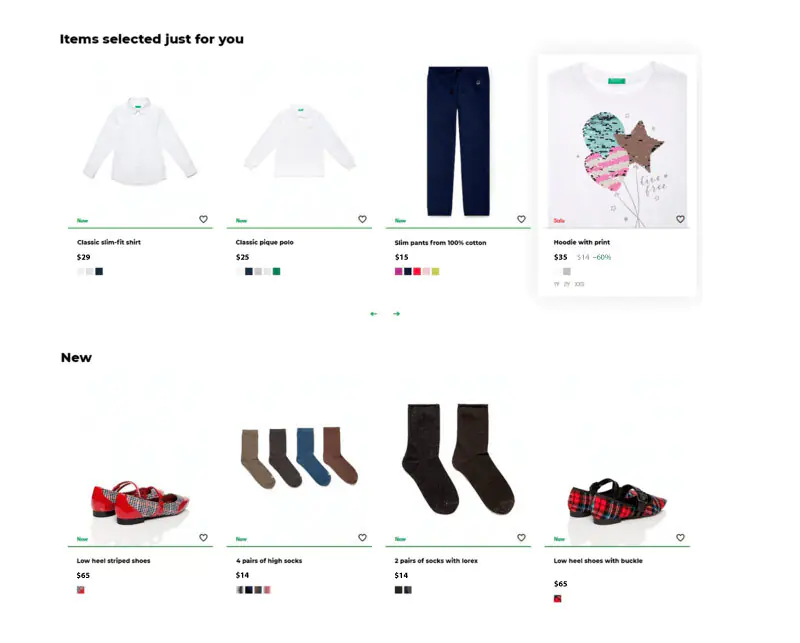
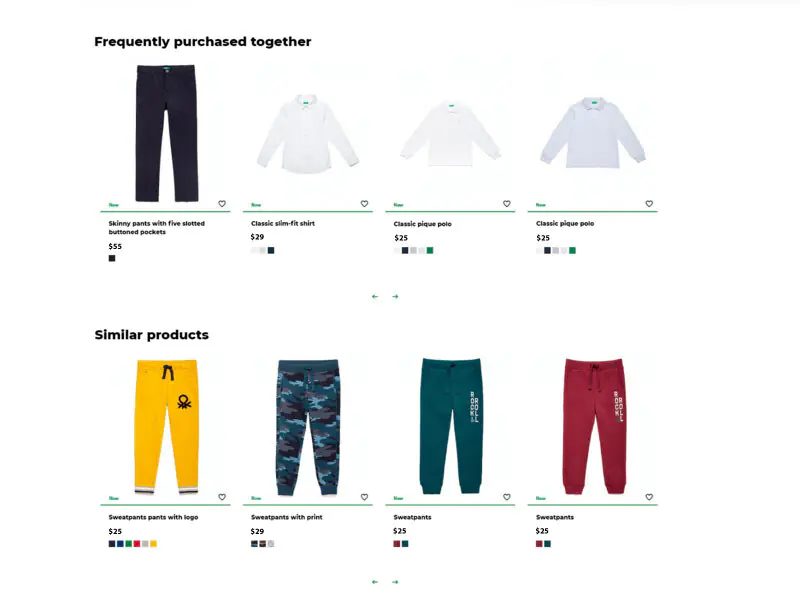
Together with Maestra, we solved the problem of combining data related to the loyalty program and launching segmented SMS and email communications. We also started working together on testing the possibilities of personalizing the website and individual customer offers, which allowed us to attain great conversion results relative to the target action.
Conclusion
Over a year of collaboration, we launched an omnichannel loyalty program with personal offers, automated campaigns over three communication channels, implemented website personalization and product recommendations with a bunch of algorithms on the website and in campaigns.
As a result, automated communications and personal promotions increased the average revenue per customer and order conversions among loyalty program participants. This brought in at least several hundred thousand dollars of additional revenue relative to the global control group, with a statistically significant result and a confidence level of 95%.
As we couldn’t cover everything in this article, we didn’t go into much detail on website personalization. If you would like to know how United Colors of Benetton personalized their website and generated revenue using this module, I invite you to read our previous blog post: United Colors of Benetton: how personalized product cards increased order conversions by 10%.

